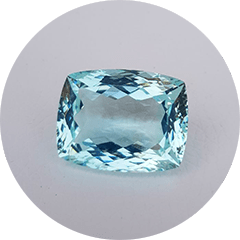
Global Gemstone Certification
Aquamarine
Aquamarine
Deriving its name from the Latin word for sea, this gemstone does have the aesthetic of clear, blue water. However, it can be discovered in shades ranging from light blue to blue-green. With heat treatment, it is possible to remove the green hues present in certain aquamarine stones. This is a cyan or blue variety of beryl. The form of the stone can be found in deposits throughout Sri Lanka. There is also a deep blue version of aquamarine. The largest Aquamarine gemstone was discovered in Marambia, Brazil in 1910. It weighed a tremendous 110 kg.
|
Chemical Formula |
Be3Al2SiO6 |
|
Color |
Blue |
|
Hardness |
7.5 – 8.0 |
|
Crystal System |
Hexagonal |
|
Refractive Index |
1.57 – 1.58 |
|
SG |
2.6 – 2.8 |
|
Transparency |
Transparent to translucent |
|
Double Refraction |
.006 |
|
Luster |
Vitreous |
|
Cleavage |
3,1 – basal |
|
Mineral Class |
Beryl (Aquamarine) |
